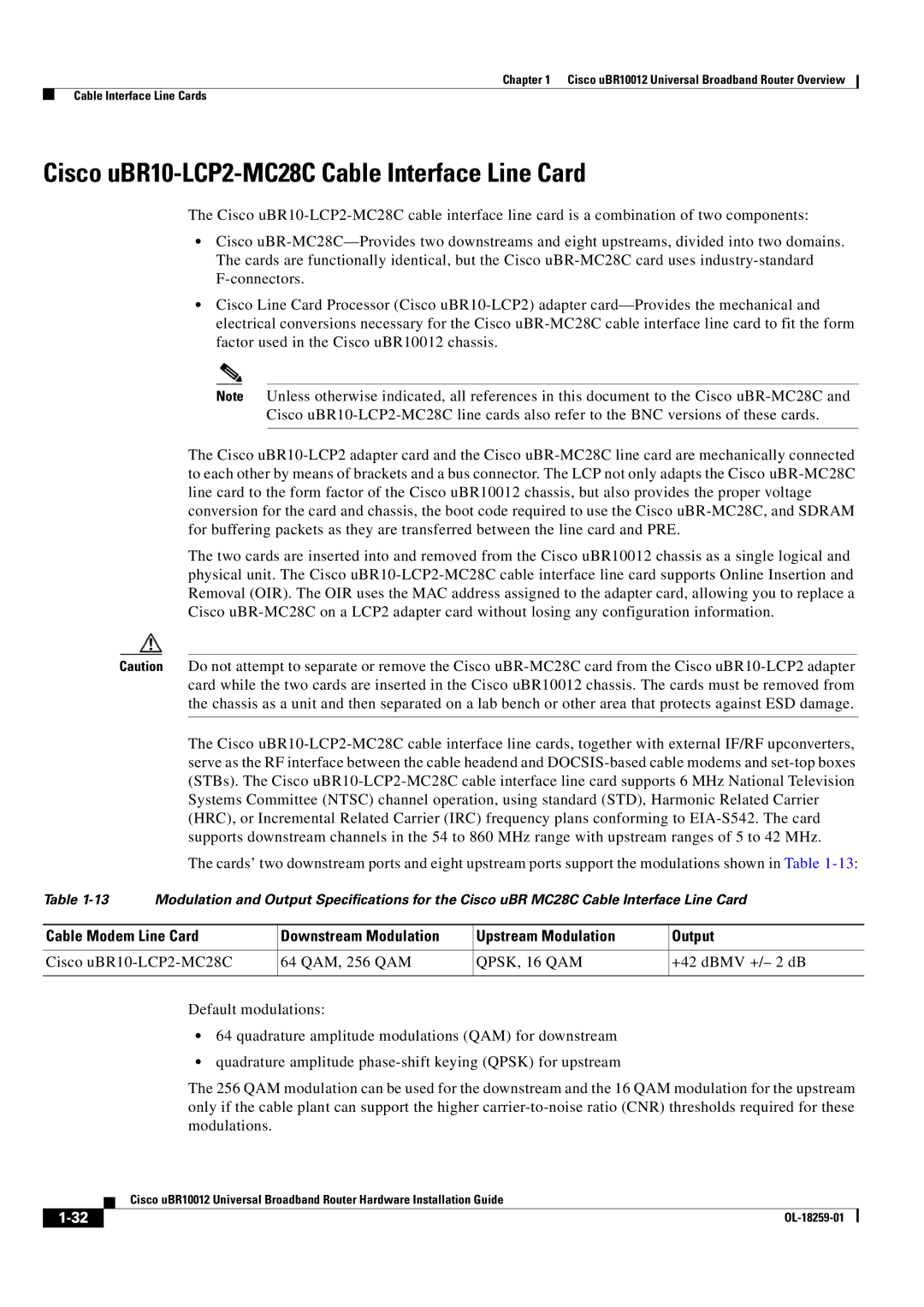Chapter 1 Cisco uBR10012 Universal Broadband Router Overview
Cable Interface Line Cards
Cisco uBR10-LCP2-MC28C Cable Interface Line Card
The Cisco uBR10-LCP2-MC28C cable interface line card is a combination of two components:
•Cisco uBR-MC28C—Provides two downstreams and eight upstreams, divided into two domains. The cards are functionally identical, but the Cisco uBR-MC28C card uses industry-standard F-connectors.
•Cisco Line Card Processor (Cisco uBR10-LCP2) adapter card—Provides the mechanical and electrical conversions necessary for the Cisco uBR-MC28C cable interface line card to fit the form factor used in the Cisco uBR10012 chassis.
Note Unless otherwise indicated, all references in this document to the Cisco uBR-MC28C and Cisco uBR10-LCP2-MC28C line cards also refer to the BNC versions of these cards.
The Cisco uBR10-LCP2 adapter card and the Cisco uBR-MC28C line card are mechanically connected to each other by means of brackets and a bus connector. The LCP not only adapts the Cisco uBR-MC28C line card to the form factor of the Cisco uBR10012 chassis, but also provides the proper voltage conversion for the card and chassis, the boot code required to use the Cisco uBR-MC28C, and SDRAM for buffering packets as they are transferred between the line card and PRE.
The two cards are inserted into and removed from the Cisco uBR10012 chassis as a single logical and physical unit. The Cisco uBR10-LCP2-MC28C cable interface line card supports Online Insertion and Removal (OIR). The OIR uses the MAC address assigned to the adapter card, allowing you to replace a Cisco uBR-MC28C on a LCP2 adapter card without losing any configuration information.
Caution Do not attempt to separate or remove the Cisco uBR-MC28C card from the Cisco uBR10-LCP2 adapter card while the two cards are inserted in the Cisco uBR10012 chassis. The cards must be removed from the chassis as a unit and then separated on a lab bench or other area that protects against ESD damage.
The Cisco uBR10-LCP2-MC28C cable interface line cards, together with external IF/RF upconverters, serve as the RF interface between the cable headend and DOCSIS-based cable modems and set-top boxes (STBs). The Cisco uBR10-LCP2-MC28C cable interface line card supports 6 MHz National Television Systems Committee (NTSC) channel operation, using standard (STD), Harmonic Related Carrier (HRC), or Incremental Related Carrier (IRC) frequency plans conforming to EIA-S542. The card supports downstream channels in the 54 to 860 MHz range with upstream ranges of 5 to 42 MHz.
The cards’ two downstream ports and eight upstream ports support the modulations shown in Table 1-13:
Table 1-13 | Modulation and Output Specifications for the Cisco uBR MC28C Cable Interface Line Card |
| | | |
Cable Modem Line Card | Downstream Modulation | Upstream Modulation | Output |
| | | |
Cisco uBR10-LCP2-MC28C | 64 QAM, 256 QAM | QPSK, 16 QAM | +42 dBMV +/– 2 dB |
| | | | |
Default modulations:
•64 quadrature amplitude modulations (QAM) for downstream
•quadrature amplitude phase-shift keying (QPSK) for upstream
The 256 QAM modulation can be used for the downstream and the 16 QAM modulation for the upstream only if the cable plant can support the higher carrier-to-noise ratio (CNR) thresholds required for these modulations.
| Cisco uBR10012 Universal Broadband Router Hardware Installation Guide |
1-32 | OL-18259-01 |

